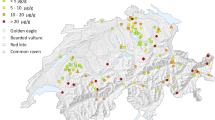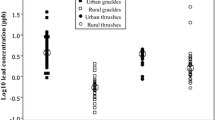Abstract
Lead is toxic to humans and wildlife. Most studies of lead exposure of raptors focus on the winter, non-breeding season when they scavenge heavily. We evaluated blood lead concentrations (BLCs) of red-shouldered hawks (Buteo lineatus) during the non-scavenging season in the eastern United States. BLCs of 53 of 70 hawks were above the limit of detection (\(\bar{x}\) = 9.25 µg/dL ± 19.81; ± SD). Adult hawks had higher BLCs (\(\bar{x}\) = 12.86 µg/dL ± 24.72) than did nestlings (\(\bar{x}\) = 3.25 µg/dL ± 2.62; p ≤ 0.001, χ2 = 13.2). There was no difference in BLCs of adult hawks among physiographic provinces but there were differences between urban and non-urban settings (p = 0.04, χ2 = 4.2). Soils and invertebrate hawk prey also had quantifiable lead concentrations. Our work shows that red-shouldered hawks are exposed to lead when not scavenging, and suggests pathways by which these birds may be exposed.

Similar content being viewed by others
References
Burger J, Gochfield M (2000) Effects of lead on birds (Laridae): a review of laboratory and field studies. J Toxicol Environ Health B 3:59–78
Cade TJ (2007) Exposure of California condors to lead from spent ammunition. J Wildl Manag 71:2125
Cruz-Martinez L, Redig PT, Deen J (2012) Lead from spent ammunition: a source of exposure and poisoning in bald eagles. Hum-Wildl Interact 6:94–104
Dykstra CR, Hays JL, Daniel FB, Simon MM (2000) Nest site selection and productivity of suburban red-shouldered hawks in southern Ohio. The Condor 102:401–408
Dykstra CR, Hays JL, Simon MM, Daniel FB (2003) Behavior and prey of nesting red-shouldered Hawks in southwestern Ohio. J Raptor Res 37:177–187
Dykstra CR, Hays JL, Crocoll ST (2008) Red-shouldered gawk (Buteo lineatus), version 2.0. In: Poole AF (ed) The Birds of North America. Cornell Lab of Ornithology, Ithaca
Edens FW, Garlich JD (1983) Lead-induced egg production decrease in leghorn and Japanese quail hens. Poultry Sci 62:1757–1763
Fallon JA, Redig P, Miller TA, Lanzone M, Katzner T (2017) Guidelines for evaluation and treatment of lead poisoning of wild raptors: guidelines for lead poisoned raptors. Wildl Soc B 41:205–211
Fenneman NM (1938) Physiography of eastern United States. McGraw-Hill Book Co., New York
Friend M, Laitman CJ, Kampen RS (1987) Field guide to wildlife diseases. General field procedures and diseases of migratory birds, vol 1. US Fish and Wildlife Service, Washington, DC
Grade TJ, Pokras MA, Laflamme EM, Vogel HS (2018) Population-level effects of lead fishing tackle on common loons: population effects of lead tackle. J Wildl Manag 82:155–164
Hanchette CL (2008) The political ecology of lead poisoning in eastern North Carolina. Health Place 14:209–216
Henny CJ, Schmid FC, Martin EM, Hood LL (1973) Territorial behavior, pesticides, and the population ecology of red-shouldered hawks in central Maryland, 1943-1971. Ecology 54:546–554
Henny CJ, Blus LJ, Hoffman DJ, Grove RA, Hatfield JS (1991) Lead accumulation and osprey production near a mining site on the coeur d’Alene River, Idaho. Arch Environ Contam Toxicol 21:415–424
Jachowski DS, Katzner T, Rodrigue JL, Ford WM (2015) Monitoring landscape-level distribution and migration Phenology of Raptors using a volunteer camera-trap network: raptor camera-trap**. Wildl Soc B 39:553–563
Jensen MK, Hamburg SD, Rota CT, Brinker DF, Coles DL, Manske MA, Slabe VA, Stuber MJ, Welsh AB, Katzner TE (2019) An improved mechanical owl for efficient capture of nesting raptors. J Raptor Res 53:14–25
Katzner TE, Stuber MJ, Slabe VA, Anderson JT, Cooper JL, Rhea LL, Millsap BA (2018) Origins of lead in populations of raptors. Anim Conserv 21:232–240
Langner HW, Domenech R, Slabe VA, Sullivan SP (2015) Lead and mercury in fall migrant golden eagles from western North America. Arch Environ Contam Toxicol 69:54–61
Lee L (2017) NADA: Nondetects and data analysis for environmental data. R package version-1. https://CRAN.R-project.org/package=NADA
Lewis LA, Poppenga RJ, Davidson WR, Fischer JR, Morgan KA (2001) Lead toxicosis and trace element levels in wild birds and mammals at a firearms training facility. Arch Environ Contam Toxicol 41:208–214
MacGregor-Fors I (2011) Misconceptions or misunderstandings? On the standardization of basic terms and definitions in urban ecology. Landsc Urban Plan 100:347–349
Martin EM (2004) Decreases in a population of red shouldered hawks nesting in central Maryland. J Raptor Res 38:312–319
Martin LK, Black MC (1998) Biomarker assessment of the effects of coal strip-mine contamination on channel catfish. Ecotoxicol Environ Saf 41:307–320
Pokras MA, Kneeland MR (2008) Lead poisoning: using transdisciplinary approaches to solve an ancient problem. EcoHealth 5:379–385
Pranty B (2002) Red-shouldered hawk feeds on carrion. J Raptor Res 36:152–153
Pyle P (2008) Molt limits in North American passerines. N Am Bird Bander 22:49–89
R Core Team (2018) R: a language and environment for statistical computing. R Foundation for Statistical Computing, Vienna, Austria. https://www.R-project.org/
Rogers TA, Bedrosian B, Graham J, Foresman KR (2012) Lead exposure in large carnivores in the greater Yellowstone ecosystem. J Wildl Manag 76:575–582
Scheuhammer AM, Bond DE, Burgess NM, Rodrigue J (2003) Lead and stable lead isotope ratios in soil, earthworms, and bones of American woodcock (Scolopax minor) from eastern Canada. Environ Toxicol Chem 22:2585–2591
Schooley T, Weaver M, Mullins D, Eick M (2009) The history of lead arsenate use in apple production: comparison of its impact in Virginia with other states. J Pestic Saf Educ 10:22–53
Slabe VA, Anderson JT, Cooper J, Brown B, Ortiz P, Buchweitz J, McRuer D, Katzner T (2019) Lead in piscivorous raptors during breeding season in the Chesapeake Bay region of Maryland and Virginia. Environ Toxicol Chem. https://doi.org/10.1002/etc.4376
Smith DB, Cannon WF, Woodruff LG, Solano F, Kilburn JE, Fey DL (2013) Geochemical and mineralogical data for soils of the conterminous United States: U.S. Geological Survey Data Series 801, 19 p., https://pubs.usgs.gov/ds/801/
Strobel BN, Boal CW (2010) Regional variation in diets of breeding red-shouldered hawks. Wilson J Ornithol 122:68–74
Therneau T (2015) A package for survival analysis in R. version 2.38, https://CRAN.R-project.org/package=survival
Townsend, KAL (2006) Nesting ecology and sibling behavior of Red-shouldered Hawks at the St. Francis sunken lands wildlife management area in northeastern Arkansas. Ph.D. dissertation, Arkansas State University, Jonesboro
Weakley, AS, Ludwig JC, Townsend JF, Crowder B (2012) Flora of Virginia. Botanic Research Institute of Texas Press
Acknowledgements
L. Rhea, D. Schmidt and B. Brown assisted data collection. The Avian Conservation Center of Appalachia and Wildlife Center of Virginia provided blood samples. TK and JC raised funds. VS, AW, and MJ collected blood samples. PO and VS prepared blood samples. PO and TK obtained permits for field work. VS led writing and data analysis and all authors assisted with revisions. All field work was covered under WVU’s IACUC protocol #1603001797 and federal banding permit #23715. This publication was completed with funds provided by the Virginia Department of Game and Inland Fisheries through a Federal Aid in Wildlife Restoration grant from the United States Fish and Wildlife Service, contract #2013-14308. V. Slabe was supported by the West Virginia University Outstanding Merit Fellowship for Continuing Doctoral Students. JA was supported by the NSF (OIA-1458952) and the USDA National Institute of Food and Agriculture, McIntire Stennis project WVA00117. Any use of trade, product or firm names is for descriptive purposes only and does not imply endorsement by the U.S. Government.
Author information
Authors and Affiliations
Corresponding author
Electronic supplementary material
Below is the link to the electronic supplementary material.
Rights and permissions
About this article
Cite this article
Slabe, V.A., Anderson, J.T., Cooper, J. et al. Lead Exposure of Red-Shouldered Hawks During the Breeding Season in the Central Appalachians, USA. Bull Environ Contam Toxicol 103, 783–788 (2019). https://doi.org/10.1007/s00128-019-02732-9
Received:
Accepted:
Published:
Issue Date:
DOI: https://doi.org/10.1007/s00128-019-02732-9




